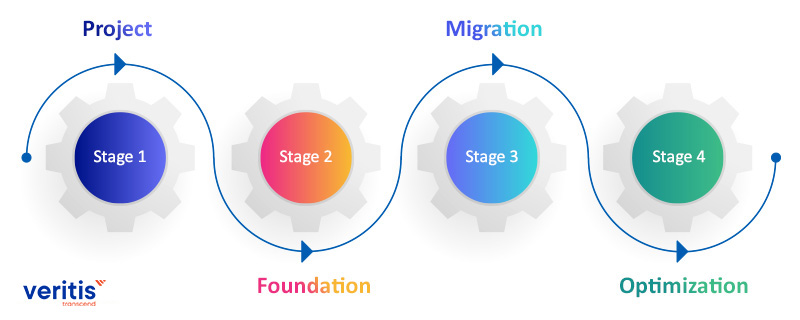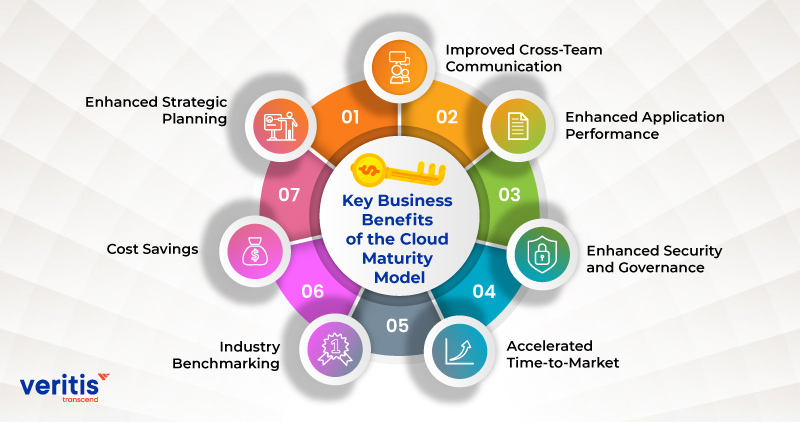
Cloud Computing has always been at the forefront of the ever-changing IT industry. Cloud adoption has ramped up after the globe increasingly relies on IT solutions. The increased appetite has encouraged enterprises to initiate cloud transformation of their infrastructure.
Given its outstanding business benefits, every organization, irrespective of size and revenue, is leveraging the cloud computing strategy in one way or another.
In 2023, according to Forrester research, the cloud maturity model industry is experiencing remarkable growth, with the global market projected to reach USD 1.5 billion by 2025, up from USD 750 million in 2022. According to Gartner, this surge is accompanied by a rapid adoption rate, with over 60% of organizations implementing cloud maturity models. These organizations are reaping numerous benefits, including improved cloud adoption, cost reduction, and increased agility.
RightScale’s 2023 State of the Cloud Report found that 92% of IT decision-makers recognize cloud maturity as essential to their organization’s success. Flexera’s 2023 State of Cloud Computing Report found that 78% use these models to accelerate digital transformation initiatives. Furthermore, Cloudability’s 2023 Cloud Migration Report found that 65% employ them to enhance security while 58% optimize cloud costs. These statistics collectively underline the industry’s growing importance in the ever-evolving cloud technology landscape.
Although businesses worldwide are already quite advanced in utilizing cloud optimization services, many are ultimately failing to get the total value of their cloud transformation. Many organizations perceive cloud assessment as just another technology project. They neglect to address the critical changes required to imbibe the right organizational mindset, behavior, and culture.
Precisely at this juncture, the Cloud Computing Maturity Model (CCMM) proves to be an advantage as cloud based infrastructure is the need of the hour.
Key Takeaways:
- The cloud maturity model is a multidimensional approach that assesses a company’s readiness for cloud transformation.
- The CMM considers business objectives, technology perspectives, organizational mindset, behavior, and culture.
- If you are unsure what to do first and where to start, Veritis can help you make it happen.
Useful Link: Hybrid Cloud Vs Multi Cloud: What’s the Difference!
Defining Cloud Maturity Model (CMM)

The Open Alliance for Cloud Adoption (OACA) defines CMM as:
A framework for identifying specific solutions to enterprise cloud/hybrid IT adoption. The cloud maturity model (CMM) thereby seeds a road map to cloud adoption, pointing to potential gaps and possible frameworks and solutions to consider and identifying capabilities required to achieve specific maturity levels and address targeted use cases.
It describes the cloud maturity model as an effective means to analyze an organization’s current cloud state and plan the implementation of cloud technologies.
With business objectives in consideration, a cloud maturity model perfectly defines the target state and offers cloud transformation services to perform a gap analysis to reach the level of cloud maturity assessment. However, it takes the services of a cloud infrastructure provider to model a practical cloud migration strategy.
Besides, it precisely answers ‘How should a journey to cloud assessment and hybrid IT look like’ for cloud security maturity model users of all levels, from beginners to mid-level to experienced.
Useful Link: IAM Best Practices for Optimal Cloud Security
How the Cloud Maturity Model (CMM) Helps?

The Cloud Maturity Model (CMM) typically assists enterprises in multiple ways:
- The Cloud Maturity Model (CMM) typically assists enterprises in multiple ways:
- Understand the cloud maturity model from the consumer and service provider’s perspective.
- Define goals and develop a cloud assessment.
- Determine target maturity levels to enable use cases for the cloud security maturity model in line with business objectives.
- Develop straightforward roadmap projects that boost maturity levels of all cloud optimization capabilities and domains to realize the implementation of desired use cases.
- The plan focused investment towards attaining maturity levels to cloud capabilities and cloud optimization.
- Manage priorities about cloud adoption and cloud computing infrastructure.
- Tap the potential to achieve the complete cloud benefits.
In traditional environments, organizations should plan a cohesive, practical cloud migration plan and cloud strategy to reap the financial and organizational benefits of the cloud maturity model.
Here are some specific examples of how the cloud maturity model can have a positive impact on the cloud and the way we behave and interact with one another:
1) Improved Communication and Collaboration: Cloud computing facilitates seamless collaboration on projects, regardless of geographic location, simplifying teamwork for dispersed teams. For instance, teams can use cloud-based project management tools to share files, track progress, and communicate with each other. This can lead to boost productivity and efficiency.
2) Increased Innovation: Cloud computing provides businesses with extensive resources and tools, enabling them to foster innovation and create novel products and services. For example, companies can leverage cloud-based machine learning and artificial intelligence services to craft customized offerings that resonate more effectively with their customer base.
3) Improved Customer Service: Utilizing cloud computing, businesses can enhance their customer service capabilities by equipping themselves with the necessary tools to gain deeper insights into and address their customers’ requirements. For instance, companies can leverage cloud-based customer relationship management (CRM) software to monitor customer engagements and deliver tailored assistance.
Cloud Adoption Strategy: Navigating the Challenges and Finding the Way Forward
Enterprises often find themselves at a crossroads when effectively managing their cloud adoption strategy. The urgency brought about by the pandemic has led to hurried decisions, such as opting for quick lift-and-shift approaches that may not yield the desired outcomes.
Lift-and-shift, in this context, refers to the act of moving applications to the cloud security maturity model without addressing the broader transformation needs of the organization’s culture and processes.
Some enterprises make ambitious promises but underestimate the effort required to achieve them. Upon realizing the magnitude of the task, they hit roadblocks, and their migration efforts stalled before they could fully unlock the cloud’s true potential. Consequently, they expose themselves to significant operational and financial risks.
While this situation is not uncommon, it raises a crucial question: How can enterprises avoid losing their way in their cloud adoption journey? The solution lies in embracing a comprehensive and structured migration model.
Useful Link: Best Practices that Lead to Good Cloud Governance
Achieving Cloud Maturity: 4 Stages of Transformation

The Cloud Maturity Model (CMM) helps build a clear-cut cloud roadmap by analyzing maturity in terms of technical and non-technical capabilities.
While the technical perspective measures cloud maturity in terms of cloud and ICT, the non-technical perspective does so by cloud business applications, such as cloud service and deployment models.
The cloud transformation security maturity model lays down the path for an effective strategy to successful cloud adoption. Built on four stages: Project, Foundation, Migration, and Optimization, the cloud maturity model defines characteristics in each stage of the cloud migration plan, followed by transformation and outcomes at the end of every stage.
Maturity Stage 1: Project
| Challenges | Outcomes |
| Limited awareness about cloud adoption | Organizational knowledge and assistance |
| Limited executive support on investment | Proper support and appropriate funding |
| Inability to purchase required services | Ability to purchase all that required |
| Less confidence in cloud optimization | Boosted confidence and decreased resistance |
| Inability to own or lack of direction | Strong ownership, strategy and direction |
Maturity Stage 2: Foundation
| Challenges | Outcomes |
| Assigning resources that drive cloud transformation | Dedicated resources for cloud computing infrastrucure |
| Lack of organizational cloud transformation plan | Detailed plan: People, Process and Technology |
| Security and compliance concerns | Best practices, policies and architecture |
| Cost and management concerns | Detailed TCO for operating environment |
Maturity Stage 3: Migration
| Challenges | Outcomes |
| Developing an effective cloud migration strategy | Clear-cut strategy from current to target state |
| Implementing migration process | Cost-effective, efficient application cloud optimization |
| Environment management concerns | Robust management and effective governance |
| Migration of all targeted applications | Successful moving to the cloud and significant benefits |
Maturity Stage 4: Optimization
| Challenges | Outcomes |
| Cost management optimization | Robust process for continuous cost optimization |
| Service management optimization | Optimized management, customer satisfaction |
| App management service optimization | Rigorous optimized app management services |
| Enterprise service optimization | Optimized enterprise services |
These four cloud maturity models promise analysis, capability and efficiency gains, velocity and quality, and proactiveness.
Beginning with an analysis of the existing environment, the cloud maturity model involves:
- Finding opportunities specific to the cloud based infrastructure.
- Introducing relevant tooling.
- Measurable controls to manage cloud strategy.
- Effective cloud optimization.
Useful Link: 7 Most-Productive Google Cloud Tools One Must Have!
Key Business Benefits of the Cloud Maturity Model

1) Enhanced Strategic Planning
- By assessing your current maturity level using a relevant CMM, you gain insights into the strengths and weaknesses of your cloud adoption.
- This assessment helps prioritize areas with the potential for the most significant impact on your organization’s cloud strategy.
- Consequently, your cloud strategy becomes more focused and efficient, avoiding investments in low-value objectives that might waste time and resources.
2) Improved Cross-Team Communication
- A CMM provides a structured framework that teams can use to communicate their cloud strategy, goals, and progress to various stakeholders.
- With a shared understanding of where the organization stands regarding cloud maturity, teams can work together more effectively and ensure alignment with overall business objectives.
- This unified vision fosters better collaboration and minimizes misunderstandings among teams and stakeholders.
3) Enhanced Application Performance
- As organizations progress through the stages of a CMM, a significant focus is placed on optimizing the performance of cloud-based applications.
- This optimization involves identifying and eliminating bottlenecks, reducing latency, and ensuring high availability and reliability.
- The result is improved application performance, which leads to better user experiences, increased productivity, and potentially higher customer satisfaction.
4) Enhanced Security and Governance
- CMMs typically include best practices and guidelines for cloud security and governance.
- By following these practices, organizations can strengthen their security posture in the cloud environment.
- This approach includes better access control, data encryption, compliance adherence, and regular security assessments.
- It also enhances the ability to identify vulnerabilities and potential exploits in the cloud infrastructure, reducing security risks.
5) Accelerated Time-to-Market
- Advanced stages of a CMM encourage organizations to use cloud-based resources more efficiently.
- This efficiency translates into faster development and deployment of applications and services.
- Companies can respond more quickly to market demands, roll out new features, and adapt to changing business requirements, accelerating their time-to-market.
6) Industry Benchmarking
- CMMs often provide industry-specific Key Performance Indicators (KPIs) and benchmarks.
- These metrics allow organizations to measure their cloud maturity progress compared to peers and competitors in the same industry.
- Benchmarking helps organizations gain valuable insights into where they stand relative to industry standards and where improvements are needed.
7) Cost Savings
- Advancing through the stages of a CMM encourages organizations to focus on efficiency and automation.
- This emphasis on optimization reduces day-to-day operational expenses associated with cloud usage.
- It also helps prevent costly cloud sprawl, where unused or underutilized resources lead to unnecessary expenses.
A CMM provides a structured approach to improving cloud adoption by addressing various aspects of strategy, communication, performance, security maturity model, efficiency, industry alignment, and cost management. Each of these advantages contributes to a more mature and effective cloud environment for organizations.
Conclusion
The first step in harnessing the benefits of the cloud maturity model is educating the people working on the organization’s cloud security maturity model transformation about the cloud maturity levels and their components. Once you get a clear picture of your company’s cloud capabilities and the targeted cloud maturity levels, it will be easier to seek more information and support to reach your goal. If you are unsure where to start, please get in touch with us.
Veritis, the Stevie and Globee Business Awards winner, can help you better understand the cloud maturity model and how technology, processes, and people relate to various aspects of cloud maturity assessment. Our cloud experts help you with our effective cloud migration plan so that cloud migration is on par with the business objectives. Partner with Veritis and make the most of your cloud transformation.
Explore Cloud Services Looking for Support? Schedule A Call
[WPSM_AC id=13719]
Additional Resources:
- AWS Vs Azure Vs GCP – The Cloud Platform of Your Choice?
- The 5-Step Strategy to Manage and Optimize Public Cloud Costs
- Best Practices that Lead to Good Cloud Governance
- Cloud Adoption in Government Sector: What’s the Trend?
- Cloud Cost Optimization and Management
- Cloud Benefits to Automotive Industry
- What is a Lift and Shift Cloud Migration?
- Cloud Governance Services and Solutions